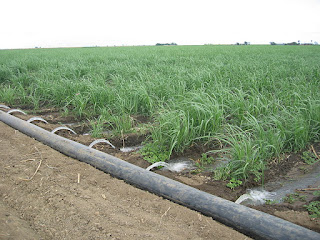Irrigation -
Irrigation is defined as the process of artificial supply of water to soil for raising crops.
Types of Irrigation
Followings are the types of irrigation methods-
1. Surface Irrigation
2. Localized Irrigation
3. Drip Irrigation
4. Sprinkler Irrigation
5. Center Pivot Irrigation
6. Lateral Move Irrigation
7. Sub-Irrigation
8. Manual Irrigation
1. Surface Irrigation -
Water is scattered equally throughout the land with the help of gravitational pull and it doesn’t require a machine to take care of it. This consists of a vast amount of irrigation methods in which water is scattered, the things you need to have before you introduce the irrigation water to the basins are by siphons, gated pipe. This system is best suited for areas that have a parallel slope or flat surface and a moderate fine-textured soil type. This helps the surface to have water spread through it evenly as it moves down across the basin.
There are three types of surface irrigation:
a. Basin irrigation
b. Furrow irrigation
c. Flood irrigation
2. Localized Irrigation -
Water is scattered throughout the land under low pressure. A piped network, that passes throughout the soil, is used for water distribution so that all the plant gets water effectively.
3. Drip Irrigation -
In this process of drip irrigation, the water drops fall on the root of every plant that is around the system. The plants absorb the dropped water using their roots. In this process, the evaporation and runoff are minimized so we can ensure less water loss.
4. Sprinkler Irrigation -
Water is scattered throughout the land by high-pressure sprinklers or guns from the equator of the land or from a moving platform that would be sprinkled as it moves.
5. Center Pivot Irrigation -
Water is scattered throughout the land by a machine of sprinklers that move on wheeled towers in 360 degrees pattern or a circle that would move around the land and sprinkle water all over the soil and it is really efficient and effective and this procedure or system is well recommended in a lot of countries but mostly used in the USA.
6. Lateral Move Irrigation -
Water is scattered throughout the land evenly through a series of pipes or water lines, they can either be controlled by hands which could be less effective compared to a man-made machine for sprinkling water all over the land. The sprinkles move only a recommended distance on the field and for the next land, the Re connection of the water hose is required to cover the next distance. Compared to the other irrigation systems, lateral move irrigation system tends to be way cheaper but requires a lot of labor or manpower.
7. Sub-Irrigation -
In this process, the surrounding water table is raised to scatter water evenly across the land. Methods like pumping stations, canals, gates, ditches, and a few other systems are used to raise the water table. This irrigation method is one of the most effective for scattering water throughout the areas with a high water table.
8. Manual Irrigation -
Water is scattered across evenly around the field with the help of manual power such as labors and watering cans. This system is very labor concentrated. Each of these methods is useful in its own specific way and it depends on how you are using it and what you are using it on. The lade matters as sometimes the best irrigation system might seem to have flaws in it. Make sure you determine the soil you are using and check whether you have a good supply reservoir filled with water around you which would make it easier for you to take care of your plants.
Written By :- Er Harneet Singh























0 Comments